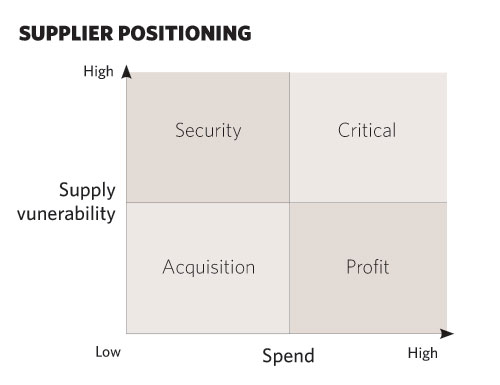SCDigest
Editorial Staff
| SCDigest Says: |
 It is no use trying to get strategic or collaborate with a supplier that isn't interested in doing so.. It is no use trying to get strategic or collaborate with a supplier that isn't interested in doing so..
|
Many supply management and procurement professionals, especially those in Western Europe, are familiar with the Kraljic Matrix for strategically positioning suppliers.
The matrix was developed by Peter Kraljic and first published as part of a Harvard Business Review article in 1983. The core of the model, as shown in the graphic below, is to rank suppliers based on two dimensions (high or low):
- The amount of company spend with the supplier
- How vulnerable a company is to a supplier's failure or disappearance
The result is a traditional 2 x 2 matrix the creates quadrants that position a supplier and define a company's strategic approach to that supplier (Kraljic later made enhancements to the model, including a 3 x 3 version, and there have been many refinements of this by others over the years):
Kraljic Matrix

The four types of relationships are:
- Acquisition: Many suppliers, buyers dominate. Focus on supply chain optimization, efficient procurement processes, and receiving bids from many suppliers
- Profit: Lots of suppliers, but big impact on company if supply is disrupted; so, consider target pricing strategies and umbrella contracts with preferred suppliers.
- Security: Few suppliers, but not a lot of financial risk from supplier failure; so, consider volume insurance contracts, maintaining buffer stock, and always be on look out for alternative suppliers.
- Critical: The company depends on the suppliers. Generally, the company will look for performance-based partnerships, with market and technology leaders, owning specific know-how. The balance of power between buyers and suppliers can be vary quite bit. Consider strategic alliances, building close relationships, even vertical integration.
There have been a number of criticisms of the Kraljic model over the years, including a recent one by
Andy Williams of CPM Training.
He sees two important issues:
1. This model
it does not take into account the supplier’s perception of the buyer, clearly an issue of some importance. The buyer's view of how important the relationship is, based on the buyer's view of spend alone, often would be seen differently through the supplier's eyes.
2. Thinking only in terms of supply risk is too limiting. The better question, says Williams, is:
Could this supplier contribute to a real improvement in the way the buying organization works and competes? He terms this "supplier strategic potential."
(Sourcing
and Procurement Article - Continued Below)
|